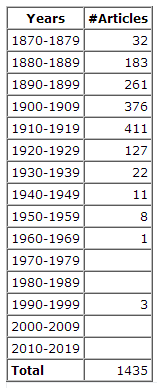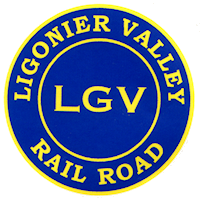Ligonier Valley Rail Road Newspaper Articles
 We have compiled over 1,400 newspaper articles that mention the Ligonier Valley Railroad, or related subjects. The articles were originally published starting in 1873 and our collection runs through 1995. Enjoy!
We have compiled over 1,400 newspaper articles that mention the Ligonier Valley Railroad, or related subjects. The articles were originally published starting in 1873 and our collection runs through 1995. Enjoy!
Ligonier Echo
Wednesday, October 10, 1888
A Trip To Long Bridge
What Our Reported Saw on a Visit to Booth & Flynn's Stone Quarry
On last Wednesday we took a run down the Ligonier Valley railroad as far as Long Bridge with the object of visiting the blue stone quarry of Booth & Flynn, on the opposite side of the raging Loyalhanna. We first dropped into the store of Mr. Austraw, at the station, who warned us of the danger from blasts at the quarry. As we climbed the hill on the other side, however, we forgot the injunction and were almost to the quarry when the bang – bang – bang of half a dozen blasts and the rattling of stones among the trees put us on the watch. We hunted up the superintendent of the work, Mr. Alex. McCance, a very
obliging gentleman, who showed us all around and explained the work. The opening for the quarry is about 1,100 feet long, the vein being 65 feet thick. The rock is blasted off in large masses and then split up to the smaller sizes for Belgian block, which is becoming such a popular paving stone for city streets, "square heads," an inferior grade of the same, and ballast. There are twenty-six block makers at work, and they chip out the blocks at the rate of about three carloads per day. The spalls or chips from these blocks are used
for macadamizing streets. By far the greater part of the stone from the quarry is broken up for ballast. There is a ponderous crusher, run by a 40-horse power engine, into whose rapacious jaws the stone is fed, and which crushes it up into small pieces at the rate of 400 or 500 tons per day. Immediately beneath the crusher is a rapidly revolving fan which extracts all the fine dust. The broken stone is then conveyed in a long rubber belt to the screen, where it is separated into the different sizes for ballast, macadam, and the
finer material for walks, etc. When everything goes right they turn out of this material 25 carloads per day. It is carried to the railroad across the creek by a very long and high trestle work. Just now they have an order for all they can furnish for some time for ballasting the P.R.R. preparatory to inspection. The Belgian block is used almost altogether by Booth & Flynn themselves in their paving work, the being large contractors in that line.
In the engine room are set one big 54-horse power boiler which supplies steam to the crusher engine, and one of 25-horse power for the water and air pump. Here, too, is located the air reservoir for running the machine drill, this latter being a rather insignificant looking little machine, but which will do the work of ten men in drilling deep holes.
There are now at work in and about the quarry, including laborers, drillers, block makers, engineers and all, about 115 men, many of them are married and live in the
neighborhood, and quite a number boards at a boarding house near the station. On the flat ground along the pike several pretty dwellings have been built, while the Italians of whom there are about 25, live in shanties, not mingling with the English-speaking workmen.
During this month the works are run until nine o'clock at night and the appearance of the side of the mountain as it is brilliantly illuminated by several large natural gas burners, as views from the railroad is indeed picturesque and beautiful.
The quarry is well worth a trip down to see. On the opposite side of the creek is a quarry of the same kind operated by the Ligonier Block Company, also of Pittsburg, but
not nearly so extensive as the other.


 1
1